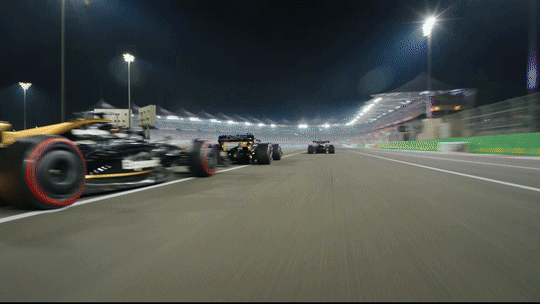Formula 1 is an objectively strange sport to enjoy. Most of the action comes bunched in the first five minutes of a race, and 20 cars sprawled across a big track is tough to keep tabs on. The viewing experience demands a lot of insider knowledge on strategy, racing tech, FIA politics, and on and on. No matter how many seasons of Drive to Survive you’ve binged, some confusion is inevitable.
F1: The Movie was announced off the heels of the wildly successful tailwinds of the aforementioned Drive to Survive, a watershed moment for the sport that properly introduced it to American audiences. While the Netflix series is dedicated to introducing the strategy, the drivers, and the ample drama wrapping it all up, there’s still one quintessential truth that cannot be fully conveyed, no matter a viewer’s F1 media literacy; those cars go goddamn FAST. And that’s where F1: The Movie comes in.
F1: The movie is a lot of things. But first, and arguably second and also likely third, the movie is a vehicle. A Formula 1 car, to be exact, built to be driven by every viewer in the audience. When I went in to see this movie, the beloved Lincoln Square IMAX theater being the only choice to do so, I hoped to feel the awesome power of a Formula 1 car translated effortlessly from track to screen. A big task to be sure, but one I had seen director Joseph Kosinski pull off before with his excellent Top Gun: Maverick. If he could put me in the cockpit of a fighter jet, surely he could give me the best seat in the house for a Formula 1 race.
And needless to say, Kosinski cooked. He delivered on this movie’s promise tenfold, achieving easily the most immersive pure action experience I’ve felt in a movie since the aforementioned Top Gun. Surprisingly, he even outdid himself with F1 in certain ways. I found myself squirming in my seat, gripping my armrests tight as our heroes rounded impossibly tight turns and engaged in impossibly fast-paced scrums with other drivers where a single millimeter of driver error could mean total disaster. The cars are jankier, more grounded, even more accessible-feeling than a fighter jet. We’ve all gotten behind the wheel (albeit for far less dramatic purposes), and maybe had to pump the brakes a little too quickly. We know what that jolt feels like, and Kosinski weaponizes that familiarity to put the viewer in the shoes of his drivers, sometimes almost too well.
This phenomenon isn’t a one-trick pony either. The nuances of individual races, team strategies, even weather patterns hurl daunting obstacles at our drivers that mold the texture of the film’s audiovisual storytelling. I can’t remember the last time storm clouds made me tense up in a movie. And the triumphs at the end of the finish line feel particularly earned because of it, to the point where I’m not embarrassed to admit I pumped my fist a little. It’s a marvelous technical filmmaking achievement that solely justifies the movie’s existence, with the caveat that you give it the IMAX treatment it deserves to really unlock its highest gear.
Unfortunately, F1: The Movie is not just a rollercoaster ride. It’s still gotta be a movie too. And that’s where you start to encounter problems. Brad Pitt stars as a former driver who comes out of retirement to net his old friend Javier Bardem a race win before he’s forced to sell his F1 team for incompetence, Dan Snyder style. Only guess what? Pitt’s character is fighting Demons baby. It’s a pretty generic setup that isn’t helped much by Pitt’s “Brad Pitt type” character he clearly can do in his sleep at this point. The script doesn’t choose to get any more groundbreaking from there, following all the story beats an action blockbuster could be expected, with montages and inciting incidents that couldn’t be timed more predictably. The cherry on top is a never-ending series of dialogue choices that skew harder towards Madame Web than anyone might be willing to admit. This movie had its priorities laid bare, and readily sacrificed the supporting elements of a holistic film to reach its goal of total Formula 1 immersion.
The friction of brilliant technical achievements against so many other elements that are clearly half-baked yields a movie experience that’s less good and more entertaining. And you know what? I’m happy with that fact. F1 didn’t need to be Citizen Kane, and I suspect I had far more fun because of that fact. For instance, the dialogue was the funny kind of bad, not the boring kind:
Young girl in a nightclub: Are you a driver? Joshua: Yes I am. Girl: Can you introduce me to Carlos Sainz?
Ruben: Sometimes when you lose, you win.
And you know what? A sleepwalking Brad Pitt performance is still about 10x more charming than the next actor up. A predictable plot was periodically interrupted by delightfully absurd “plan C” moments in the fictional F1 team’s strategy, which almost elicited a good spit take out of me. The very real Formula 1 drivers that cameo throughout also catch endless strays across the script, which I suspect will buoy ample laughs out of casual and serious Formula 1 fans alike.
I had a damn good time watching this movie. Was some of that enjoyment me laughing at it? Sure, but plenty more came at the hands of some very real and very special action filmmaking. This movie is a big win in the sense that I was engaged constantly, alternately sucked into and pulled out of the movie’s spell in a way that was so many things, but definitely never boring.
Verdict: 3/5 (3.5 if you watch in IMAX, and 4/5 if the filmmakers had the guts to add a “Shake and Bake” line to the mix)





